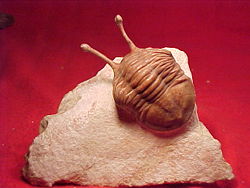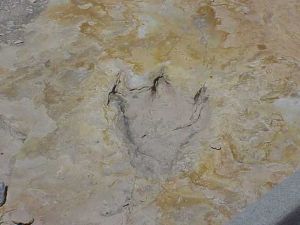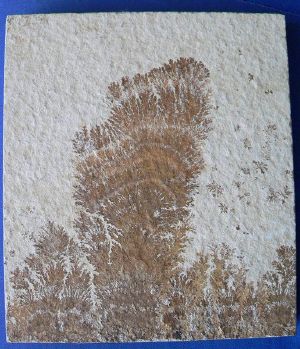Fossil
Fossils (from Latin fossus, literally "having been dug up") are the mineralized or otherwise preserved remains or traces of animals, plants, and other organisms. The totality of fossils and their placement in fossiliferous (fossil-containing) rock formations and sedimentary layers (strata) is known as the fossil record. Paleontology is the study of the developing history of life on Earth, of ancient plants and animals, based on the fossil record,
Fossils usually consist of traces of the remains of the organism itself. However, fossils may also consist of the marks left behind by the organism while it was alive, such as the footprints or feces of a dinosaur or reptile. These types of fossil are called trace fossils, as opposed to body fossils.
Past life leaves some evidences that cannot be seen, but can be detected in the form of chemical signals; these are known as chemical fossils. For example, characteristic compounds may be found in oils traced to ancient algae and bacteria, or molecules found in source rocks and sediments may provide information about other ancient organisms. An organic compound called oleanane has been considered valuable in providing information about the origin of flowering plants.
The oldest known structured fossils are most likely stromatolites. Stromatolites are commonly thought to have been formed by the entrapment and cementation of minerals by microorganisms, especially cyanobacteria. The oldest of these formations dates from 3.5 billion years ago. Even older deposits (3.8 billion years old) of heavy carbon that are indicative of even earlier life are currently proposed as the remains of the earliest known life on Earth.
Types of fossils and fossilization processes
Fossilization is actually a rare occurrence because natural materials tend to decompose. Fossilization requires the relatively quick preservation of bodily remains. Normally, the remains need to be covered by sediment or trapped in resin as soon as possible. However there are exceptions to this, such as if an organism comes to rest in an anoxic environment (without oxygen) at the bottom of a lake.
It stands to reason that greater numbers of fossils will be found involving big organisms with hard body parts, species that were widespread, and species that were in existence for a long time. Small, soft bodied organisms living in localized areas and belonging to species that had a short existence are difficult sources of fossils. Geological processes such as erosion and subduction also destroy many fossils. For such reasons, fossils are somewhat rare.
There are several different types of fossils and fossilization processes.
Permineralization

Permineralization consists of organic remains being to some degree infiltrated by minerals derived from the surrounding sediments or waters. For permineralization to occur, the organism must become covered by sediment soon after death or soon after the initial decaying process. This may include being covered by volcanic ash, mud, sand, gravel, or other fine-grained sediments. The degree to which the remains are decayed when covered determines the later details of the fossil. The chemicals in the organic material are slowly replaced with hard, rock-like minerals, such as calcite, iron, and silica. Over millions of years the remains are completely replaced by the minerals, leaving a rock-like copy.
Some fossils consist only of skeletal remains or teeth; other fossils contain traces of skin, feathers, or even soft tissues.
Replacement fossils
In some cases, the original remains of an organism were completely dissolved or otherwise destroyed after covered by sediments. When all that is left is an organism-shaped hole in the rock, it is called a mould fossil or typolite. If this hole later had been filled with other minerals, it is called a cast fossil and is considered a replacement fossil, since the original materials had been completely replaced by new, unrelated ones. At times, replacement had occured so gradually and at such fine scales that no "hole" in the rock can ever be discerned, and microstructural features are preserved despite the total loss of original material.
Compression fossils
A compression fossil is a fossil preserved in sedimentary rock that has undergone physical compression. Compression fossils, such as those of fossil ferns, involve chemical reduction of the complex organic molecules composing the organism's tissues, and physical compression. In this case, the fossil consists of original material, albeit in a geochemically altered state.
While it is uncommon to find animals preserved as good compression fossils, it is very common to find plants preserved this way. The reason for this is that physical compression of the rock often caused distortion of the fossil. Since leaves are basically flat, the resulting distortion is minimal. Plant stems and other three-dimensional plant structures do not preserve as well under compression. The best fossils of leaves are found preserved in layers of sediment that had been compressed in a direction perpendicular to the plane of the deposited sediment.
Typically, only the basic outline and surface features are preserved in compression fossils. Internal anatomy is not preserved.
Compression fossils are formed most commonly in environments where fine sediment was deposited, such as in river deltas, lagoons, along rivers, and in ponds. The best rocks in which to find these fossils preserved are clay and shale, although volcanic ash may sometimes preserve plant fossils as well.
Resin fossils
Smaller animals, such as insects, spiders and small lizards, can be trapped in resin (amber), which is secreted from trees. These fossils can be found in sandstones or mudstones or washed up on beaches like those around the Baltic Sea.
Trace fossils
Trace fossils are the remains of trackways, burrows, footprints, eggs and eggshells, nests, droppings and other types of impressions. Fossilized droppings, called coprolites, can give insight into the feeding behavior of animals and can therefore be of great importance.

Trace fossils are those details preserved in rocks that are indirect evidence of life. While we are most familiar with relatively spectacular fossil hard part remains such as shells and bones, trace fossils are often less dramatic, but nonetheless very important. Trace fossils include burrows, track marks, coprolites (fossilized feces), stromatolites (fossilized algal mounds), and rhizoliths or rhizocretions (fossil remains of roots).
The study of trace remains is called ichnology, which is divided into paleoichnology, or the study of trace fossils, and neoichnology, the study of modern trace remains. Another name for trace fossils is ichnofossils, taken from the Greek word ichnos, meaning "trace".
The science of ichnology is quite challenging, as many trace remains cannot be positively assigned to a specific organism. Furthermore, trace remains such as burrows can make the work for paleontologists and geologists more difficult as they rework sediments, causing older strata to be mixed with a younger ones. This can cause some confusion in interpretation unless viewed in context.
Trace fossils are generally divided into five groups (by Adolf Seilacher, Yale University):
- Domichnia are dwelling structures,
- Fodinichnia are feeding traces left by animals which eat their way through sediment,
- Pascichnia are grazing traces made on the surface of the sediment,
- Cubichnia are resting traces (for example where an animal may have stopped and rested on the sea floor),
- Repichnia are surface traces of creeping and crawling.
Confusion with other types of fossils
Pseudofossils are sometimes confused as being trace fossils. Trace fossils should not be confused with body casts. The Ediacara and Burgess shale fauna remains for instance primarily consist of the casts of these organisms in the sediment.
Early geologists who studied the markings found on the bedding planes of sedimentary rocks gave them the name 'Fucoid', and they applied this name to a wide variety of markings and interpreted them as being the fossilized remains of seaweed. However, in more recent years these markings have been studied with greater thoroughness and it is now apparent that the 'Fucoids' and other markings have in fact been caused by a variety of organisms, and are now termed trace fossils.
Information provided by ichnofossils
Paleo-ecology
Trace fossils provide us with indirect evidence of life in the past, such as the footprints, tracks, burrows, borings, and droppings left behind by animals, rather than the preserved remains of the body of the actual animal itself. Unlike most other fossils which are produced only after the death of the organism concerned, trace fossils provide us with a record of the activity of an organism during its lifetime.
Trace fossils are formed by organisms performing the functions of their everyday life, such as walking, crawling, burrowing, boring, or feeding. Tetrapod footprints, worm trails, and the burrows made by clams are all trace fossils.
Fossil footprints made by tetrapod vertebrates are difficult to identify to a particular species of animal, but they can provide us with valuable information, such as the speed, weight, and behavior of the organism which made them. Such trace fossils are formed when amphibians, reptiles, mammals or birds walked across soft, probably wet, mud or sand which later hardened sufficiently to retain the impressions before the next layer of sediment was deposited.
Perhaps the most spectacular trace fossils are the huge, three-toed footprints produced by dinosaurs. They give scientists clues how these animals lived. Although the skeletons of dinosaurs can be reconstructed, only their fossilized footprints can determine exactly how they stood and walked. Such tracks can tell us a lot about the gait of the animal which made them, what its stride was, and whether or not the front limbs touched the ground.
However, most trace fossils are rather less conspicuous, such as the trails made by worms. Some of these worm castings are the only fossil record we have of these creatures.
Use as index fossils
Some trace fossils can be used as local index fossils to date the rocks in which they are found, such as the burrow Arenicolites franconicus which occurs in a 4 cm (1.6") layer of the Triassic Muschelkalk epoch throughout wide areas in southern Germany.
Identification of the trackmaker
The organisms which produce trace fossils are usually not preserved with their markings, and although it may be possible to deduce what the animal was doing at the time, it is usually impossible to determine the maker of the trace conclusively and to assign it to a given species of animal. Since different types of organisms are able to make the same types of markings, trace fossils are usually classified by their shape and their cause (such as feeding, dwelling, or crawling), rather than by the types of organisms which made them.
The usual classifications for trace fossils are ichnogenera for genera and ichnospecies for species. It should be emphasized that ichnogenera and ichnospecies are artificial classifications that apply only to the trace fossils themselves, and do not relate to genus or species of the organisms which produced them.
Inherent bias and principle of actualism
Most trace fossils are known from marine deposits. Essentially, there are two types of traces, either exogenic ones which are on the surface of the sediment (such as tracks), or endogenic ones which are within the layers of sediment (such as burrows).
Surface trails on sediment in shallow marine environments stand less chance of fossilization because they are subjected to wave and current action. Conditions in quiet, deep-water environments tend to be more favourable for preserving fine trace structures.
Most trace fossils are usually readily identified by reference to similar phenomena in modern environments. This method is known as the principle of actualism. However, the structures made by organisms in recent sediment have only been studied in a limited range of environments, mostly in coastal areas including tidal flats. Many trace fossils were formed within the sediment itself, by infaunal species rather than just at the surface, so it is more difficult to compare them to modern forms.
Examples
Trace fossils are found in abundance in rocks from the upper part of the Ediacaran period, some 550 million years ago, with the earliest occurrences in the Proterozoic (more than 1 billion years ago). One well known occurrence of trace fossils from this period is the famous 'Pipe Rock' of northwest Scotland. The 'pipes' which give the rock its name are closely packed straight tubes, which were presumably made by some kind of worm-like organism. The name given to this type of tube or burrow is Skolithos, which may be 30 cm (12") in length and between 2 to 4 cm (0.8 to 1.6") in diameter. Such traces are known worldwide from sands and sandstones deposited in shallow water environments from the Cambrian period onwards.
Other common types of trace fossil made by invertebrates are Chondrites, Cruziana, Thalassinoides, Asteriacites, Rhizocorallium and Teichichnus. These are all ichnogenera.
Chondrites are small branching burrows of the same diameter which superficially resemble the roots of a plant. The most likely candidate for having constructed these burrows is a nematode (roundworm). Chondrites are found in marine sediments from the Cambrian period onwards and are especially common in sediments which were deposited in reduced oxygen environments.
Cruziana are excavation trace marks made on the sea floor which have a two-lobed structure with a central groove. The lobes are covered with scratch marks made by the legs of the excavating organism, usually a trilobite or allied arthropod, and in fact several different types of trilobite have been discovered at the end of Cruziana trails. Cruziana are most common in marine sediments formed during the Palaeozoic era, particularly in rocks from the Cambrian and Ordovician periods. Over 30 species of Cruziana have been identified.
Thalassinoides are burrows which occur parallel to the bedding plane of the rock, and are extremely abundant in rocks worldwide from the Jurassic period onwards. They are repeatedly branched, with a slight swelling present at the junctions of the tubes. The burrows are cylindrical and vary from 2 to 5 cm (0.8" to 2") in diameter. Thalassinoides sometimes contain scratch marks, droppings, and also the bodily remains of the crustaceans which made them.
Asteriacites is the name given to the five-rayed fossils found in rocks, and they record the resting place of starfish on the sea floor. Asteriacites are found in European and American rocks from the Ordovician period onwards, and are numerous in rocks from the Jurassic period of Germany.
Rhizocorallium is a type of burrow, the inclination of which is typically within 10° of the bedding planes of the sediment. These burrows can get very large, over a metre long in sediments that show good preservation, e.g. Jurassic rocks of the Yorkshire Coast (eastern UK), but the width is usually only up to 2 cm, restricted by the size of the organisms producing it. It is thought that they represent fodinichnia as the animal (probably a nematode) scoured the sediment for food.
Teichichnus has a distinctive form produced by the stacking of thin 'tongues' of sediment atop one another. They are again believed to be fodinichnia, with the organism adopting the habit of retracing the same route through varying heights of the sediment, which would allow it to avoid going over the same area. These 'tongues' are often quite sinuous, reflecting perhaps a more nutrient-poor environment in which the feeding animals had to cover more sediment in order to acquire sufficient nourishment.
The oldest types of tetrapod trace fossils date back to the Upper Devonian period and are found in Scotland (including the hibbertopteroid track) Pennsylvania, and Australia.
Important hominid trace fossils are the Laetoli footprints, imprinted in volcanic ash.
Pseudofossils
Pseudofossils are visual patterns in rocks that are produced by naturally occurring geologic processes rather than biologic processes. They can easily be mistaken for real fossils. Some pseudofossils, such as dendrites, are formed by naturally occurring fissures in the rock that get filled up by percolating minerals. Other types of pseudofossils are kidney ore (round shapes in iron ore) and moss agates, which look like moss or plant leaves. Concretions, round or oval-shaped nodules found in some sedimentary strata, were once thought to be dinosaur eggs, and are often mistaken for fossils as well.
Living fossils
Living fossil is a term used for any living species which closely resembles a species known from fossils, i.e., as if the fossil had "come to life". This can be a species known only from fossils until living representatives were discovered, such as the coelacanth and the ginkgo tree, or a single living species with no close relatives, such as the horseshoe crab, that is the sole survivor of a once large and widespread group in the fossil record.
See also
- Compression fossil
- Collecting fossils
- Fossils and the geological timescale
- Fossil fuels
- Prehistoric life
- Transitional fossil
ReferencesISBN links support NWE through referral fees
- Journal of Applied Sciences and Environmental Management, Vol. 9, No. 1, 2005, pp. 45-49
Geochemical Implication of some Chemical Fossils as Indicators of Petroleum Source Rocks
OSUJI, L. C; ANTIA, B. S.
- Taylor, Thomas N. & Taylor, Edith L. (1993). The Biology and Evolution of Fossil Plants. Englewood Cliffs, NJ: Prentice Hall. ISBN 0-13-651589-4.
External links
- The Virtual Fossil Museum throughout Time and Evolution
- http://www.english.fossiel.net/ - Fossil collecting locations in Europe
- Paleozoic.org: Paleontology discussion group, gallery of fossil photography
- EPaleo Fossil Forum
Credits
New World Encyclopedia writers and editors rewrote and completed the Wikipedia article in accordance with New World Encyclopedia standards. This article abides by terms of the Creative Commons CC-by-sa 3.0 License (CC-by-sa), which may be used and disseminated with proper attribution. Credit is due under the terms of this license that can reference both the New World Encyclopedia contributors and the selfless volunteer contributors of the Wikimedia Foundation. To cite this article click here for a list of acceptable citing formats.The history of earlier contributions by wikipedians is accessible to researchers here:
The history of this article since it was imported to New World Encyclopedia:
Note: Some restrictions may apply to use of individual images which are separately licensed.

